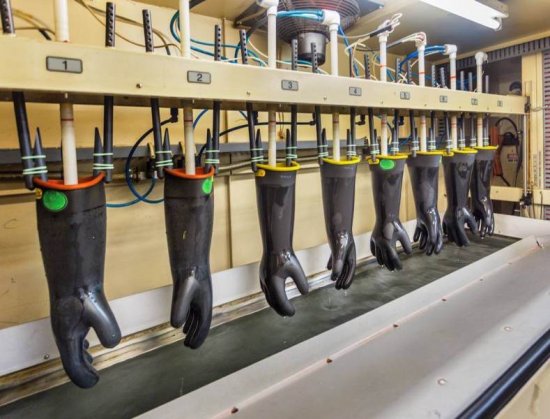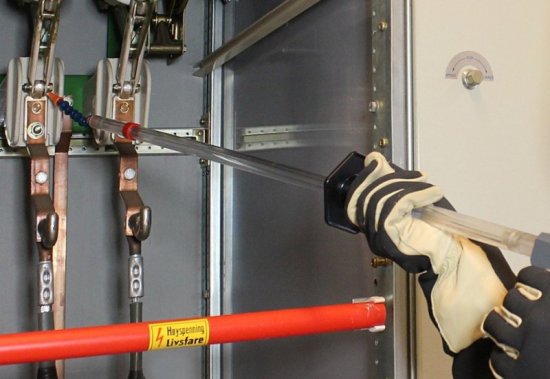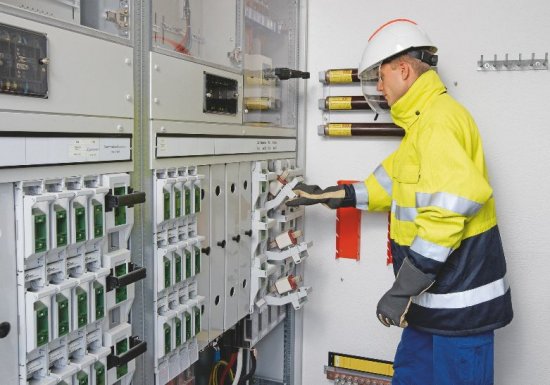Conditions for testing electrical protective equipment
The use of electrical protective equipment in electrical installations is one of the main measures to protect service personnel from electric shock. Protective devices fulfill their isolation function only under the condition of their integrity, technical serviceability and sufficient dielectric strength for the voltage class for which they are used.
For timely detection of defects, reduction of dielectric strength below the permissible level electrical laboratory tests of protective equipment are periodically performed… In this article we will look at the time to test electrical protective equipment used to carry out work in electrical installations.
Dielectric gloves
Dielectric gloves are subjected to increased voltage once every six months.
Periodic testing of gloves does not guarantee that they will be suitable for use throughout their service life, as dielectric gloves can be damaged during use.
If the gloves are torn or seriously damaged, they are completely removed from service. In the event that the damage is minor, then this protective equipment is handed over ahead of schedule for periodic inspection to determine the possibility of their further operation.
If visible damage to the gloves can be found during the next inspection, then a minor puncture cannot be identified visually. The presence of even a slight puncture indicates that the dielectric gloves are no longer suitable and their use is dangerous to the life of the personnel.
Therefore, before each use of dielectric gloves it is necessary to check them for leaks, that is, for the absence of punctures. To do this, the dielectric gloves from the edge begin to wrap towards the fingers and, holding the rolled edge, press the glove to make sure that the air does not escape.
It should also be borne in mind that in case of improper storage of dielectric gloves, when they were exposed to direct sunlight for a long time, were stained with lubricants or stored near various destructive chemicals, dielectric strength the gloves are removable. In this case, they must be submitted for testing, regardless of whether the next test has come or not. The same applies to other protective means made of dielectric rubber - boat and galoshes, as well as insulating mats, caps, pads.
Dielectric shoes
The testing period for dielectric boots is once every three years, and for dielectric wellies - once a year. These protective devices should be checked for damage before each use.In case of visible damage, this protective equipment is submitted for emergency inspection to determine its suitability for further use.
Voltage indicators, measuring clamps and measuring rods
Voltage indicators (including phase check indicators), clamps and rods for measuring current, voltage and power, light signal indicators for cable line failure are tested once a year.
Before use, the voltage indicator (measuring stick, clamp, etc.) is checked for integrity and operability. In case of detection of visible damage to the insulating part, as well as in the presence of a malfunction, this protective device is handed over for repair and early testing.
Insulating rods, clamps, rods for grounding installation
Operating bars and insulating clamps with voltage class up to and above 1000 V are tested once every two years… Rods for the installation of portable grounding in electrical installations with a voltage class of 110 kV and higher, as well as insulating flexible elements of portable grounding of wire-free structures for electrical installations of 500 kV and higher, are tested at the same frequency.
Insulating rods for installation of equipment grounding up to and including 35 kV are not subject to periodic tests. Serviceability is determined by visual inspection for damage before each use and at the next scheduled inspection of protective equipment.
Insulating caps, pads, hand tools
Insulating pads, caps and other insulating means for performing live work (ladders, insulators, etc.), insulating parts of hand tools are tested once every 12 months.
When carrying out work under voltage, it is necessary to periodically check the integrity of the insulating means, since the integrity of the insulating elements can be violated during the work.
Insulation mats (stands)
Rubber insulating mats and dielectric stands not subject to testing… These protective devices provide their insulating properties in the absence of moisture, contamination and damage to the insulating part — the surface of the dielectric pad or the post insulators.
Portable protective earthing
Portable grounding not subject to testing… An indicator of their suitability is the absence of damage to the wires (the damage is no more than 5%), as well as the operability of the clamps - they must ensure reliable contact of the portable ground with live parts of the electrical installation equipment, as well as with the grounding point .
Accounting and periodic inspection of protective equipment
In order for protective equipment to be always tested and ready for use, it is necessary to organize their accounting and periodic inspection.
For accounting and control over the state of protective equipment a special diary «accounting and storage of protective means» is kept, in which, for each protective device, its inventory number, the date of previous and subsequent tests are registered.
Protective equipment is organized for timely identification of defective or subject to further testing periodic checks... The frequency of inspections is determined by the management of the enterprise. The date of the periodic inspection and the result of the inspection shall be recorded in the logbook of the protective equipment.
In addition, electrical protective equipment is additionally checked immediately before the start of the working day (work shift) in the electrical installation, so that if the use of protective equipment becomes necessary, for example, when eliminating an emergency situation, operational switching, the employee is confident of their availability and readiness to perform work.
After the next test of the electrical protective equipment on it a special label is attached… It indicates the date of the next test, the name of the enterprise or department to which this protective equipment is assigned, as well as the inventory (serial) number, which is used to keep records of the protective equipment in the corresponding log.
Additionally
A question
Can technical rubber gloves be used as dielectric if they have passed the test in our laboratory?
Answer
According to the Rules for the use and testing of protective equipment used in electrical installations, only dielectric gloves specially made for this purpose are allowed as protective equipment in accordance with the requirements of the relevant GOST or technical conditions. Rubber gloves intended for other purposes (technical, chemical and other) as a protective means in electrical installations are not allowed.



